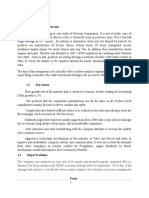Topic 1 - Lesson 2 Reading-Walmart
Topic 1 - Lesson 2 Reading-Walmart
Uploaded by
Magno PaucarCopyright:
Available Formats
Topic 1 - Lesson 2 Reading-Walmart
Topic 1 - Lesson 2 Reading-Walmart
Uploaded by
Magno PaucarOriginal Description:
Original Title
Copyright
Available Formats
Share this document
Did you find this document useful?
Is this content inappropriate?
Copyright:
Available Formats
Topic 1 - Lesson 2 Reading-Walmart
Topic 1 - Lesson 2 Reading-Walmart
Uploaded by
Magno PaucarCopyright:
Available Formats
INTERNATIONAL BUSINESS STRATEGY IN ACTION
Wal-Mart
In 2001, Wal-Mart became the worlds biggest company in terms of
sales revenues, a tittle it has kept to date, a breath-taking
achievement for the company that Sam Walton started in Arkansas as
recently as 1962. Indeed, with revenues of $408.214 billion for the
year ending 2009, Wal-Mart is now ahead of General Motors and
Exxon Mobil. The second lagest retailer, Carrefour with revenues of
$121.452, is only about one-fourth the size of Wal-Mart.
Wal-Marts success can be attributed to a scale strategy based on
reduction of costs to steadily generate its always low prices formula
and physical growth or market coverage. The United States offers the
perfect landscape for Wal-Marts expansion. Large, wealthy suburbs
with vast, inexpensive land allow the firm to set up huge warehousestyle retail centers, reducing overall prices.
This is complemented by an entrepreneurial culture in wich store
managers have a lot of decision-making power. Wal-Mart pushes its
suppliers to provide the best product they can at the lowest possible
price, making its products of better quality than those of other
discount stores.
Presently, Wal-Mart commands an 8% share of the retail sales in its
home market and its growth shows no signs of slowing down any time
soon. The firms critics accuse it of exploting its workers, destroying
traditional retail stores and eroding the manufacturing industry by
importing from countries with low labor costs, among other things.
Even those who sympathize with objectors, however, might not resist
saving $100 for an appliance. The criticism can be argued both ways.
Some traditional retail stores suffered as a result of Wal-Marts
expansion, but if Wal-Mart set up show shop in a run-down mall,
neighboring stores benefit from the increased traffic. This might
include dollar-stores, haircutting places, and sportswear outlet,
among others. Wal- Marts bicycle section falls short of offering all the
equipment, not to mention the service, of a traditional bicycle store. A
mother buying her daughter her first bicycle might go to Wal-Mart,
but a young woman looking for quality, accessories, service and a
knowledgeable salesperson might instead visit her local bike store.
The same can be said for most product sections wihin the store. Large
competitors have either stopped competing with Wal-Mart or sough
to beat it at its own game. Indeed, Wal-Mart may be responsible for a
more consumer-oriented retail service sector in the US.
One main criticism of Wal-Mart is its dependence on imports from lowcost countries such as China. In 2003, the firm purchased
approximately $1.5 billion in Chinese products, a fraction of revenues
perhaps, bua sizeable amount jus above the total revenues of
McDonalds for the same year. Here, Wal-Mart had done nothing more
than take advantage of the opportunities, available to all US retailers,
that arose from the liberalization of China.
Those things that have helped Wal-Mart grow might be the same
things that eventually will halt its growth. Low-cost laborers have a
higher turnover. The firm hires approximately 600.000 new employees
a year, and if it wants to reduce the costs of searching for personnel
and training them, it might find that increased salaries and benefits
are its only alternative. The firm has been constantly lowering the
prices of its products, this too will come to a stop when it exploits all
available opportunities in low-cost areas and as China begins to see
its production cost increase in the face of development. Finally, the
entrepreneurial nature of Wal-Mart decentralized business structure
has meant that the organization lacks a coordinated bureaucracy
with the power to impose corporate rules on store managers. For that
reason, the firm is now being plagued with lawsuits, including a class
action suit by its female employees for gender discrimination.
For future long-term growth, Wal-Mart has looked beyond its borders.
However, while it has done extremely well in Canada, Mexico and the
UK, it has had a rough time in other markets, including Germany ,
Japan and Korea.
Wal-Marts international expansion began in 1992when it entered into
a joint venture with Cifra SA, a successful Mexican retailer, in which it
held 50% interest in its partners retail operations. In 1998, Wal-Mart
acquired a controlling interest in Cifra and officially changed the
companys name to Wal- Mart of Mexico in 2000. Wal-Mart entered
Canada when it acquired 122 Woolco stores. Since then, the firm has
stablished itself successfully in the markets of its NAFTA partners. One
reason for this success is that it can rely on suppliers of its US stores
to deliver products for the Canadian and Mexican market. In addition,
the landscape, culture and economic situation in Canada are much
like in the United States.
The group entered Europa in the late 1990s, by purchasing the
Wertkauf and Interspar supermarkets in Germany. Here, Wal-Mart ran
into some trouble. Competitors in Europe had emulated the company
most successful strategies in cost reduction and supply-chain
management, reducing Wal-Marts relative competitive advantage. In
Germany, local competitors offer very low prices, and Wal-Mart is not
big enough to achieve the local economies of scale required to
compete on price alone. There was also a different cost structure.
Real estate development, when possible, was more costly and wages
were also higher. The scale effect does not work in Europe. When the
company must source 90 percent of its gods locally, wich bargain or
logistics savings can it cash in with so few stores? To top it all, WallMarts US managers hard problems adapting to the culture and did
not speak german.
Wal-Mart entered the british market by acquiring ASDA and retained
the name. ASDA had already adopted a focus on low prices an so it
had exactly the type of consumer that Wal-Mart was looking for. Even
though it has done relatively well in England, a low-cost strategy was
secondary to developing long-term relationships with suppliers of
well-known quality-oriented, different brands.
Wal-Mart launched its first store in South-Korea in 1998, but in 2005, it
ranked bottom of the nations five discount store chains. Wal-Mart
lost about 9.9 billion won in 2005 from its business in Korea, on sales
of 750 billion won. In 2006, Wal-Mart pulled out of South Korea- selling
its 16 korean stores to the country biggest discount chain. Shingsegae
paid 825 won ($882 million) for Wal-Martss South Korean operations.
Time , patient, investment and key expertise in each foreing market
may help Wal-Mart to successfully expand its international operations
to become a more international player. Until then, however, the firm
remains extremely NAFTA focused.
1. Is Wal-Mart a multinational Enterprise? Why?
2. Why is Wal-Mart making foreign direct investments in Europe?
3. Using the Porter model, what are the determinants of Wal-Marts
competitive advantage?
4. Is Wal- Marts competitiveness in Europe dependent of the same
determinants listed in question 3? Why?
You might also like
- Appellant's BriefDocument10 pagesAppellant's BriefNullumCrimen NullumPoena SineLege67% (6)
- This Study Resource Was: Business Marketing Business 500F 001 CRN 1388 Professor: HalDocument5 pagesThis Study Resource Was: Business Marketing Business 500F 001 CRN 1388 Professor: HalVikram KumarNo ratings yet
- CROCS A Revolutionizing An Industry S Supply Chain Model For Competitive AdvantageDocument4 pagesCROCS A Revolutionizing An Industry S Supply Chain Model For Competitive AdvantageHatim NathdwaraNo ratings yet
- Walmart Case Study Report-Essay #2Document12 pagesWalmart Case Study Report-Essay #2Anonymous OP6R1ZSNo ratings yet
- OTBI Training SlidesDocument48 pagesOTBI Training SlidesMn ReddyNo ratings yet
- Pyramid DoorDocument15 pagesPyramid DoorEnnovy Tsu100% (1)
- Q2. Compare and Contrast Marketing Mix Elements of Wal-Mart US and Wal-Mart ChinaDocument5 pagesQ2. Compare and Contrast Marketing Mix Elements of Wal-Mart US and Wal-Mart ChinahimfuNo ratings yet
- 031 Jiren Susan Topno IB (A) Palliser FurnituresDocument4 pages031 Jiren Susan Topno IB (A) Palliser FurnituresJiren Susan TopnoNo ratings yet
- IB Case 5Document2 pagesIB Case 5s6789a100% (2)
- International MarketingDocument24 pagesInternational MarketingranjitdhaniNo ratings yet
- Dollar GeneralDocument3 pagesDollar GeneralLaurenLechner2750% (2)
- Intel Case StudyDocument6 pagesIntel Case StudyhazryleNo ratings yet
- Groupon Competitor and Financial Analysis FinalDocument14 pagesGroupon Competitor and Financial Analysis FinalViệt Linh50% (2)
- Case Study - Global Supply ChainDocument10 pagesCase Study - Global Supply ChainNguyen LinhNo ratings yet
- Toyota's Strategy and Initiatives in Europe: The Launch of The AygoDocument15 pagesToyota's Strategy and Initiatives in Europe: The Launch of The Aygokubabubu100% (2)
- InditexDocument14 pagesInditexjack louisNo ratings yet
- Walmart Supply Chain ManagementDocument0 pagesWalmart Supply Chain ManagementVikas Sharma0% (1)
- Sample Standard Pretrial and Trial Defense MotionsDocument24 pagesSample Standard Pretrial and Trial Defense MotionsVictoria Lee100% (3)
- Case - Wal-Mart GermanyDocument6 pagesCase - Wal-Mart GermanySuper Man of SteelNo ratings yet
- (Talha) Presentation Topics For International BusinessDocument1 page(Talha) Presentation Topics For International BusinessShariq KhurshidNo ratings yet
- International Business Case StudyDocument4 pagesInternational Business Case StudyMaisha Mahmud100% (1)
- Case Study Walmart & CarrefourDocument2 pagesCase Study Walmart & Carrefourprasanna_lad11100% (2)
- Case Study On: Prepared by - Manish Motwani Zil ShahDocument17 pagesCase Study On: Prepared by - Manish Motwani Zil Shahmanish14589No ratings yet
- FACD Project - Allergan-Pfizer DealDocument5 pagesFACD Project - Allergan-Pfizer DealSaksham SinhaNo ratings yet
- Starbucks Full CasestudyDocument12 pagesStarbucks Full Casestudysajid mahmoodNo ratings yet
- Walmart Case StudyDocument11 pagesWalmart Case StudyEkta Kadav100% (1)
- Questions: 1. Assess The Financial Health of Wal-Mart Based On An Analysis of The Financial StatementsDocument1 pageQuestions: 1. Assess The Financial Health of Wal-Mart Based On An Analysis of The Financial StatementsMilton Stevens0% (1)
- Callawaygolfcompanycgc-110330093402 - Callaway Golf Company Case Analysisphpapp02Document22 pagesCallawaygolfcompanycgc-110330093402 - Callaway Golf Company Case Analysisphpapp02Snehal JoshiNo ratings yet
- Natureview Farm SolutionsDocument5 pagesNatureview Farm SolutionsRamona ElenaNo ratings yet
- Walmart Going GlobalDocument8 pagesWalmart Going GlobalKushalKaleNo ratings yet
- Analysis of Competition & Market StrategiesDocument22 pagesAnalysis of Competition & Market StrategiesnehaNo ratings yet
- Walmart-Case StudyDocument7 pagesWalmart-Case Studyhanzi caoNo ratings yet
- Wal-Mart's Failure in GermanyDocument24 pagesWal-Mart's Failure in GermanyEkansh BachchanNo ratings yet
- If ProjectDocument16 pagesIf ProjectShashank ShrivastavaNo ratings yet
- 2003 Edition: This Bibliography Contains Abstracts of The 100 Best-Selling Cases During 2002Document30 pages2003 Edition: This Bibliography Contains Abstracts of The 100 Best-Selling Cases During 2002Raghib AliNo ratings yet
- Charles SchwabDocument3 pagesCharles SchwabVinoth LoganathanNo ratings yet
- Managing Economic Exposure-New Chapter 11Document4 pagesManaging Economic Exposure-New Chapter 11MohsinKabirNo ratings yet
- WalmartDocument36 pagesWalmartMohan Lal AroraNo ratings yet
- Case Study DotcomDocument35 pagesCase Study DotcomAman AnandNo ratings yet
- Chad Cameroon PipelineDocument12 pagesChad Cameroon PipelineskhhmlNo ratings yet
- Megahertz Communications: Case DiscussionDocument2 pagesMegahertz Communications: Case DiscussionJainish PorwalNo ratings yet
- Muhammad Burhan Roll # 15739: Corporate Governance AssignmentDocument2 pagesMuhammad Burhan Roll # 15739: Corporate Governance AssignmentMuhammad BurhanNo ratings yet
- Haier Our Presentation 1228839385007165 9Document41 pagesHaier Our Presentation 1228839385007165 9mariorusso888No ratings yet
- Zara Staying Fast and Fresh Case StudyDocument2 pagesZara Staying Fast and Fresh Case StudyMichelle0% (1)
- De Beer Case SolutionDocument10 pagesDe Beer Case SolutionVarun BaxiNo ratings yet
- Analysis of Habib Metropolitan Bank LTD PakistanDocument29 pagesAnalysis of Habib Metropolitan Bank LTD PakistanMBA...KID50% (2)
- Wall Mart - MIS ReportDocument7 pagesWall Mart - MIS Reportvikrambhati100% (3)
- Japanese Distribution ChannelsDocument23 pagesJapanese Distribution ChannelsdjumekenziNo ratings yet
- Case Study of NavistarDocument12 pagesCase Study of NavistarhmsudayanganiherathNo ratings yet
- Recommender Systems: in Fashion E-Commerce: Finding The Right FitDocument14 pagesRecommender Systems: in Fashion E-Commerce: Finding The Right FitFilipeNo ratings yet
- TycoDocument10 pagesTycoAnna0082No ratings yet
- VCPE AssignmentDocument4 pagesVCPE Assignmentrbhatter007No ratings yet
- Paper 1 - Walmart in ChinaDocument4 pagesPaper 1 - Walmart in ChinaVeronica Cenci Sebald100% (1)
- American International GroupDocument3 pagesAmerican International GroupTep RaroqueNo ratings yet
- Montgras Case ReportDocument11 pagesMontgras Case ReportJoey Zahary GintingNo ratings yet
- Trader Joes AnalysisDocument2 pagesTrader Joes AnalysisywriterctNo ratings yet
- Case Study 8 (IB 2024 CLC)Document2 pagesCase Study 8 (IB 2024 CLC)gbao2003No ratings yet
- Case 2 - Wal-Marts Rising Sun 2009Document10 pagesCase 2 - Wal-Marts Rising Sun 2009Sara SaleemNo ratings yet
- Walmart Global ExpansionDocument3 pagesWalmart Global ExpansionTran Duy LinhNo ratings yet
- A Wal-Mart Neighborhood MarketDocument8 pagesA Wal-Mart Neighborhood MarketJagdeep ChughNo ratings yet
- WalmartDocument2 pagesWalmartNesru kedirNo ratings yet
- Walmart Around The World - Group 4 - Sec 2Document16 pagesWalmart Around The World - Group 4 - Sec 2Shivam GoelNo ratings yet
- Writing An Effective Report Adam LittleDocument9 pagesWriting An Effective Report Adam LittleFadi BoustanyNo ratings yet
- Notice: Meetings: Disease, Disability, and Injury Prevention and Control Special Emphasis Panel Mining Occupational Safety and Health ResearchDocument1 pageNotice: Meetings: Disease, Disability, and Injury Prevention and Control Special Emphasis Panel Mining Occupational Safety and Health ResearchJustia.comNo ratings yet
- Finance Policy Updated 01.03.16Document17 pagesFinance Policy Updated 01.03.16PartnersforinclusionNo ratings yet
- WWW - Livelaw.In: Signature Not VerifiedDocument6 pagesWWW - Livelaw.In: Signature Not Verifiedkaja100% (1)
- Memorandum To CM FOR Madhurabridge at Silchar VisitDocument4 pagesMemorandum To CM FOR Madhurabridge at Silchar VisitTonmoy PurkayasthaNo ratings yet
- For Indiabulls Embassy Group by A: July 2023Document60 pagesFor Indiabulls Embassy Group by A: July 2023Text81No ratings yet
- A Modest Proposal Jonathan Swift PDFDocument6 pagesA Modest Proposal Jonathan Swift PDFzoeNo ratings yet
- Lloyd Law College B.a.ll.b LL.B LL.M CourseDocument12 pagesLloyd Law College B.a.ll.b LL.B LL.M CourseNeha RaiNo ratings yet
- International Criminal LawDocument44 pagesInternational Criminal LawPraygod ManaseNo ratings yet
- Prezentare 28Document7 pagesPrezentare 28Oana SîrbuNo ratings yet
- IFS International Equity MarketDocument36 pagesIFS International Equity MarketVrinda GargNo ratings yet
- MacOSX10 7 MatrixDocument13 pagesMacOSX10 7 MatrixBS CNo ratings yet
- Sem - 5 Comp. Acc. NotesDocument8 pagesSem - 5 Comp. Acc. NotesRuchita KondaNo ratings yet
- Facility Application No: TWI039187910 Two Wheeler Loan Credit Application FormDocument18 pagesFacility Application No: TWI039187910 Two Wheeler Loan Credit Application FormNazumuddin ShaikhNo ratings yet
- Coffee Roasting Training Confidentiality Clause TemplateDocument2 pagesCoffee Roasting Training Confidentiality Clause TemplatePaolo SueltoNo ratings yet
- Kinds and Characteristics of PropertyDocument5 pagesKinds and Characteristics of PropertyLakshayNo ratings yet
- Mohammed Mustefa Research Proposal1Document38 pagesMohammed Mustefa Research Proposal1Mohamed MustefaNo ratings yet
- GRAP Guideline 106 - Transfer of Functions Between Entities Not Under Common ControlDocument39 pagesGRAP Guideline 106 - Transfer of Functions Between Entities Not Under Common ControlsamaanNo ratings yet
- Z1A3506455Document1 pageZ1A3506455h1014523480No ratings yet
- Hess Law Questions PDFDocument2 pagesHess Law Questions PDFTrond Henrichsen InstituteNo ratings yet
- Income SourcesDocument35 pagesIncome Sourcesirina_nircaNo ratings yet
- Mysql Connector - Version 1.1: PropertiesDocument6 pagesMysql Connector - Version 1.1: PropertiesbruxotoloNo ratings yet
- WhiteDocument4 pagesWhiteakinolaoluwafemi509No ratings yet
- BS en Iso 16890-2-2022Document3 pagesBS en Iso 16890-2-2022Marco0% (1)
- SOP-FES-10 Robbery Theft Vandalism Fire Violent CustomersDocument5 pagesSOP-FES-10 Robbery Theft Vandalism Fire Violent CustomersvikramNo ratings yet
- NLSIU Manual For InformationDocument101 pagesNLSIU Manual For InformationGh8jfyjnNo ratings yet
- Process of Payment of Fee For Vacational Training in BHEL - JhansiDocument5 pagesProcess of Payment of Fee For Vacational Training in BHEL - JhansiDevanshs005No ratings yet

























































































